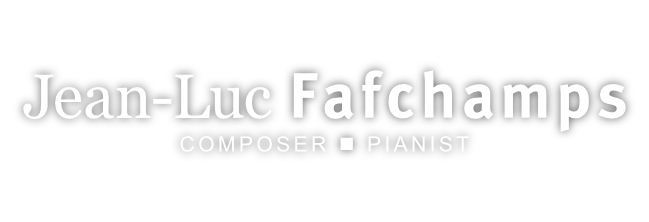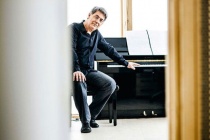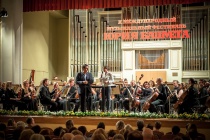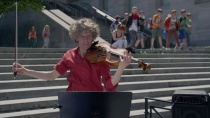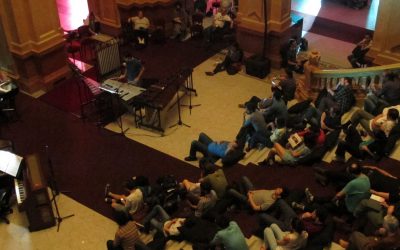Extraits de presse
Les extraits de presse sélectionnés sont présentés dans leur langue originale.
Belgische klassieke muziek in de kijker in Rusland – Knack
[…] Tenslotte was er Fafchamps’ nieuwe compositie ‘Rà’: deel 22 van ‘Lettres Soufies’, een cyclus naar het Arabische alfabet en de soeficultuur, waaraan Fafchamps sedert 15 jaar werkt. Ondanks de geringe ervaring van het orkest met nieuwlichterij bracht Vlasenko het […] tot een toegewijd zinderende première.
Een bevreemdende ervaring: een oude, naar Russische maatstaven kleine cultuurstad, een programmaboek met vertrouwde namen in cyrillisch schrift, en een volle zaal Russen, die gretig een nieuw Belgisch orkeststuk onthalen. […]
Rudy Tambuyser, 18/05/18
La rose des vents de l’Orchestre Symphonique de Mulhouse – Bachtrack
[…] La création mondiale de l’œuvre du compositeur belge Jean-Luc Fafchamps : Lettre Soufie : Fà’ offre durant quinze minutes un bouquet de sons de multiples natures, fait de tout ce que peuvent faire entendre les instruments d’un orchestre symphonique. Cette composition appartient à un ensemble d’œuvres au travers desquelles le compositeur explore la calligraphie de l’alphabet Soufi sans pour autant que cet ensemble ne constitue un opus unifié.
La pièce fait appel aux percussions pour une introduction qui, sur fond de cordes puis de vents aux accents plaintifs saisissants, s’effacent pour laisser place à un appel vif et strident de la flûte et à une vibrante sonnerie de cuivres. Le discours musical se développe ensuite à l’image de ces premiers moments aux sonorités originales et déjà pleins de contrastes étonnants : de multiples effets seront produits tels, par exemple, l’entrelacement entre silence, pianississimo, fortississimo ou encore les cordes vibrant en une sorte de sifflement ou bien les cors émettant un souffle sans son, image frappante de l’expiration de l’œuvre, à la fin. Que l’on ne s’y trompe pas cependant, rien ne survient simplement comme effet pour l’effet. Tout est construit selon une esthétique qui suscite chez l’auditeur l’attention, l’éveil de la sensibilité à chaque transition et au sein de chaque passage. Au centre de la pièce, tous les pupitres s’unissent en un tutti à l’orchestration magnifique contribuant à donner son sens à une œuvre intensément applaudie. […]
Jean Landras, 18 mai 2018
Au commencement étaient les lettres – L’Echo
En dix jours à peine, le compositeur et pianiste belge Jean-Luc Fafchamps a vu plusieurs de ses œuvres contemporaines créées à l’étranger. Dont la «Lettre Soufie Rà», au Bashmet Festival de Iaroslav, qui s’est penché pour l’occasion sur six siècles de musique belge. Reportage à travers la Russie… belgophile.
[…]
«Mais les Russes voulaient aussi un compositeur vivant», confie Patrick de Clerck, le partenaire flamand (et russophone) de cet étonnant éclairage belge.
Leur goût du conceptualisme ne pouvait que les pousser à accueillir «Djann-Louk Fafchamm», le compositeur complexe, mais non complexé, dont les œuvres contemporaines sont actuellement le plus jouées à l’étranger. Membre fondateur de l’ensemble Ictus (il a beaucoup tourné avec Rosas, la compagnie de la chorégraphe Anne Teresa De Keersmaeker), professeur d’analyse musicale au Conservatoire de Mons, Fafchamps, 58 ans, est davantage connu du grand public depuis que son écriture a injecté «un peu de douceur et de bonheur», selon lui, au terrible film «Insyriated» de son ami Philippe Van Leeuw et lui valut, parmi d’autres Magritte 2018, celui de la meilleure musique originale.
Surtout, cela fait quinze ans que ce géant à la voix grave compose une série de pièces intitulées «Lettres Soufies», qui portent chacune un numéro et un sigle de l’alphabet arabe. Fin avril, deux d’entre elles étaient d’ailleurs créées coup sur coup: «Fa», la 21e, à Mulhouse et «Ain», la 22e, à Anvers. Et voilà que la 17e, appelée «Rà» et conçue en 2010 déjà (une commande non honorée de l’Orchestre national), vient de prendre vie à Iaroslavl, grâce aux 90 musiciens de l’Orchestre symphonique moscovite Novaya Rossiya.
Drôle et mystérieux, Fafchamps en a donné les clés: «On débute ce voyage intérieur, sombre et chaotique, comme noyé au fond de l’eau. Puis une mélodie nous aide à remonter à la surface. C’est agréable… et parfois pas. Et peut-être y décèlerez-vous un illustre passage européen transformé en accord spectral.» Parmi les quelque 500 auditeurs initiaux de l’œuvre, mis à part des profondeurs abyssales traversées par des pieuvres tentaculaires et d’horribles léviathans, personne ne semble avoir reconnu quoi que ce soit. Seul le Pr. Delaere a repéré l’intrus: «Oui, il y a bien une citation de ‘L’Or du Rhin’, de Wagner, modifiée en rétrogradation…»
Oups! Pour le commun des mortels, il faudra se contenter d’une écoute dilettante de ces fulgurances aquatiques, et des commentaires bienveillants du maître sur cette première exécution publique: «Ça fait bizarre. Ils l’ont très bien interprété, même s’ils n’ont pas joué tous les détails. Mais c’est normal: il y en a tellement!» Sans regret, donc. D’autant que les spectateurs acclament, et que le génial Iouri Bashmet, plus que satisfait, a promis une large diffusion de ces lettres à travers l’interminable Russie belgophile…
Valérie Colin, mardi 15 mai 2018
Sandwich Mozart-Fafchamps, une saveur déroutante – L’Alsace
La création mondiale, Lettre soufie : Fà’, a surpris par tout un basculement. Encadrées, découpées par des effets de percussions, les structures se succédaient, violentes, angoissantes, calmes ou d’un apaisement hypnotique. Que ce soit par les dissonances ou un tapis de cordes répétant les mêmes rares notes, l’impression recherchée, le déploiement d’un monde, était bien rendue par un jeu d’atmosphères changeant et vibrant.
Jean-Claude Ober, 4 mai 2018
En blanc et noir
Fafchamps: Trois chants pour mieux voir. Debussy: Sonate pour violoncelle et piano. Elégie. Janssens: (…nada).
Aton’&Armide (Benjamin Glorieux et Sara Picavet).
5 diapasons. Technique: 5/5.
[…] Jean-Luc Fafchamps (né en 1960) réédite, d’œuvre en œuvre, la parcours qualitatif qui est le sien: ouvrir le programme sur ses Trois chants (2011-2013) a dû s’imposer, tant l’atmosphère en agrippe l’auditeur dès les premières notes pour ne plus le lâcher, avec une prise de son à couper le souffle. Un thrène chamanique, une jeu de collin-maillard, un voyage en dedans bien nommé malgré une déchirante tentative d’évasion centrale: voilà un cycle magistral d’une demi-heure, où le piano préparé sonne comme l’origine et la fin du monde. […] ce CD est une œuvre accomplie.
Diapason, Michel Stockhem, mai 2017
From post-modern to post-everything – On An Overgrown Path
There has been a flurry of interest on social media in Belgium composers, so I am giving a heads up to a composer who is unlikely to feature elsewhere. Jean-Luc Fafchamps was born in Brussels in 1960, and his music is topically relevant because of its transcultural sub-agenda and its brutally contemporary idiom – one reviewer has described him as writing in an “appealingly post-everything style, with diatonic minimalist gestures butting up against wheezy microtonal drones and so forth”. Jean-luc Fafchamps is not a Sufi or a Muslim, but his quest for a compositional system based on analogue correspondences led him to the symbolic charts known as Sufi Words created in 16th century Mughal India. He uses Sufi symbology as a compositional tool in much the same way as John Cage and his circle used the I Ching, and my 2012 post gives more details of his composing system. Lettres Soufies is envisaged as a vast network of cycles, two of which have been recorded by the Brussels based Sub Rosa label. There is an extended sample below to allow you to decide for yourself if Jean-luc Fafchamps’ music is appealingly or appallingly post-everything.
Pliable, Thursday, March 24, 2016
Gentle Electronics – La Libre Belgique
**** Un CD et un DVD pour suivre Jean-Luc Fafchamps sous de nouveaux aspects, intimement liés à une rencontre “douce” avec l’électronique. dans le premier, le piano – tenu par Stephane Ginsburgh, talentueux compagnon de route du compositeur – est au centre des échanges, introduit pas les petites percussions et leur flot d’harmoniques, le tout relayé avec une infinie subtilité pas les “machines” pour aboutir à un effet suspendu, spatial, hors du temps. Dans le second, l’auditeur suit la performance de l’altiste Vincent Royer, au pied du Mont des Arts, un dimanche de juin. Ville déserte, quelques touristes, il fait chaud. En dialogue avec l’électronique, le musicien empile les couches. Trois mouvements – passacaille, contemplation, presto final – sont accompagnés par le (double) long travelling circulaire de Manon de Boer. Hypnotique.
MDM, 9 mars 2016
Gentle Electronics – neural.it
[…] Here the Belgian musician – always remaining true to his nouveau classical approach – has released a record that includes both a CD and DVD. The work contains two distinct compositions both inspired by one clear musical idea: to choose simple electronic instruments – cheap and easy to use – and “put them to work in a mostly-theatrical way.” The world premiere of Beth/Veth was facilitated by Stephane Ginsburgh at the Conservatoire Royal de Bruxelles. Here Fafchamps continues to delight us with a composition rich with recorded percussion and electronic abstractions.
Street Music – invece – è un brano che Jean-Luc Fafchamps scrisse nel 2009 per il suonatore di viola Vincent Royer, […] fu progettato per essere eseguito in pubblico, utilizzando appunto “pop electronics” (loop effects pedals, guitar amp), cercando di cogliere le atmosfere e i suoni della città . La trasposizione filmica dell’esecuzione che troviamo oggi su DVD è stata realizzata nel 2013 da Manon de Boer che bene è riuscita a cogliere le differenti sfumature di un poetico pomeriggio di musica non convenzionale a Mont-des-Arts (Brussels).
Aurelio Cianciotta, February 19, 2016
Gentle Electronics – Obsküre
[…] Beth/Veth est un morceau résolument sombre […]. Fafchamps alterne les moments d’intensité extrême et les instants d’apaisement tendu. Car l’auditeur est malmené: lorsqu’un motif calme disparaît, il laisse la place à des accords furieux ou à une cascade de notes fougueuses, présageant une explosion dramatique scélérate. Ginsburgh interprète la partition avec un aplomb sensationnel, accentuant les effets pianistiques à l’aide des percussions. C’est d’ailleurs avec celles-ci que débute le disque. Une ouverture malicieuse qui laisse place à un minimalisme sombre avant que le romantisme ne s’impose (pour un temps). Virtuosité et maîtrise des émotions sont au rendez-vous. Fafchamps ne propose pas une musique linéaire et simple, mais au contraire riche, tout en étant accessible.
Olivier Bernard, janvier 2016
Gentle Electronics – Blow Up
[…] La prima [opera], intitolata Beth/Veth (termini che nelle lingua ebraica indicano due modi diversi di pronunciare le prime lettere della Torah), è una partitura per piano, percussioni metalliche e materiali elettronica che si dipana alternando passaggi dal vago sentore impressionista a momenti sospesi in una dimensione eterea e sfuggente, punteggiati di volta in volta da minime risonanze di oggetti metallici e dalle impercettibile intrusioni dell’elettronica digitale. La seconda è invece un lavoro visuale su dvd, in cui la composizione Street Music per viola e « pop elettronico » (delay e pedaliere che creano una graduale stratificazione di loop) si integra con i suoni di Bruxelles sviluppando una peculiare relazione fra l’esecutore Vincent Royer, il movimento dei passanti e le geometrie delle architetture che accolgono la performance come in un’ideale quinta. Un lavoro di certo non rivoluzionario né particolarmente innovativo, ma curato e non privo di spunti poetici.
Massimiliano Busti, gennaio 2016
Gentle Electronics – hhv.demag
Der Titel ist zunächst etwas irreführend. Von sanfter Elektronik, wie sie der belgische Komponist und Pianist Jean-Luc Fafchamps auf seinem Album “Gentle Electronics” ankündigt, ist erst einmal wenig zu merken. Sein Stück “Beth/Veth” beginnt vielmehr mit metallischen Perkussionsklängen, gefolgt von Klaviertönen, beides vom Pianisten Stephane Ginsburgh mit stark meditativem Gestus gespielt. Die Perkussion erinnert an die Glocken und Zimbeln bei einem buddhistischen Ritual, und die ruhigeren Klavierpassagen, repetitiv-insistierende Akkordfolgen, offenbaren eine Nähe zum französischen Komponisten Olivier Messiaen, der insbesondere für das Klavier großartige Meditationsmusiken geschrieben hat. Die elektronischen Anteile bei Jean-Luc Fafchamps werden erst allmählich aus dem akustischen Material gewonnen, mit Tonabnehmern, über die die ursprünglichen Klänge zum Teil rückwärts wiedergeben gegeben, aber alles sehr behutsam und diskret. Offensichtlicher am Werk ist die Elektronik im zweiten Stück “Street Life”, in dem der Bratschist Vincent Royer einige Figuren auf seinem Instrument spielt, daraus Loops erzeugt, und weitere Elemente live hinzuspielt, die dann wieder geloopt werden. Anfangs schichtet er daraus einen minimalistischen Groove, später verdichten sich die Linien zu einem Gewirr, aus dem sich nach und nach wieder ruhigere Stimmen herausschälen. Eine Straßenmusik – die Komposition ist im Freien aufzuführen – mit gelegentlichen Verkehrsgeräuschen und durchaus hypnotischen Qualitäten.
Tim Caspar Boehme, 02.12.2015
Gentle Electronics – Rockirella
[…] Due modi di mescolare colto e popolare nell’eterno gioco di contrapposizioni duali.
Roberto Mandolini, gennaio 2016
Morton Feldman en el Colón: reloj, detén tu camino – clarin.com
For Philip Guston, en el Foyer del Colón.
La obra infinita de Morton Feldman se oyó en el Foyer del Colón en una magistral ejecución del Ensamble Ictus de Bélgica.
El sábado tuvo lugar uno de los momentos más esperados del ciclo Colón Contemporáneo, acaso de toda la temporada de conciertos: la ejecución en el Foyer del teatro de For Philip Guston, la obra de casi cinco horas ininterrumpidas que Morton Feldman compuso para trào: piano que alterna con celesta; flauta que alterna con piccolo y flauta en sol; y un set de vibrafón, marimba, glockenspiel y campanas. Hay un fino principio de complementariedad instrumental, como si se tratase de tres instrumentos “ampliados”.
[…]
La entrega del Ensamble Ictus de Bélgica -el pianista Jean-Luc Fafchamps, el flautista Michael Schmid y el percusionista Miquel Bernat- no pudo ser más fluida y conmovedora. Los músicos se ubicaron en el centro del Foyer y la mayor parte del público tomó asiento en la escalinata principal, tapizada de almohadones. Un segundo público más circunstancial iba y venàa, gente que entraba libremente para conocer el Foyer por el Paseo de Carruajes. También estaban los que leàan o jugaban ajedrez. Todo en el mayor silencio.
El Foyer no tiene una acústica ideal, desde luego; cada tanto se oàa el tránsito de la calle Libertad y ruidos varios. Pero nada parecàa importar demasiado ni romper una atmósfera informalmente dichosa. Y además el Foyer proporcionó la contraparte “gustoniana”, pictórica, con una puesta de luces (Minou Maguna y Matàas Sendón) proyectadas desde fuera del teatro, a la manera de un intensificado y bellàsimo crepúsculo.
Ficha
For Philip Guston
Intérpretes: Ensamble Ictus (Bélgica): Jean-Luc Fafchamps (piano), Michael Schmid (flautas) Miquel Bernat (percusión) Sala: Foyer del Teatro Colón, sábado 21, de 15 a 20. Calificación: Excelente.
Federico Monjeau – 24/11/2015
Gentle Electronics (CD/DVD by Sub Rosa) – www.vitalweekly.net
[…] ‘Beth/Veth’ is a forty-eight minute piece for piano, metallic percussion and electronics.[…] This piece has a very modern classical feel to it, with a very light touch at the piano most of the times, and the percussion being somewhat oriental in approach. The pianist (Stephane Ginsburgh ) of duty here plays these. A piece that moves through various sections and which is a true beauty.
On DVD we find ‘Street Music’, for ‘plugged viola’ (played by Vincent Royer) […]. There is a slow 360-degree panorama shot of the environment and shots of the violinist himself. He plays a very vibrant, wild piece, reading from a score with instructions […]. The music is very loud and wild, but looking some of the bystanders’ reactions, it seems it wasn’t that loud on the street itself, but judging the applause, people enjoyed it; so did I, a lot actually.
FdW (Frans de Waard) – 24 novembre 2015
Triadic memories / MaerMuzik-Festival – bachtrack.com
[…] Man würde vermuten, dass bei bei dieser dauerhaften Fülle an Eindrucken auch die Aufnahmefähigkeit eines Zuhörers nachlässt, doch Jean-Luc Fafchamps’ Interpretation von Feldmans Klavierwerk Triadic Memories zur Mittagszeit belehrte eines besseren. Hierbei wurde, wie schon zuvor beim Streichquartett, das Klavier verstärkt. Die maschinellen Geräusche der Lautsprecher verbreiteten eine gewisse Unruhe, drangen sie doch in jede tonlose Pause der Musik ein, was jedoch zu einer mystischen Stimmung führte. Jean-Luc Fafchamp gab sich meisterhaft dem Nachhall seines Klavierspiels hin und zog anderthalb Stunden hohe Aufmerksamkeit auf sich.[…]
Saori Kanemaki, 01 April 2015
The Grand Design – www.thesoundprojector.com
YZ3Z2Z1S2, a Five-letter Sufi Word
The work of noted Belgian composer Jean-Luc Fafchamps was hitherto entirely new to this reviewer. Materially, and in terms of attitude, direction and format, however, there is nothing here that would immediately surprise or trouble those with a working knowledge of avant-garde and contemporary orchestral music. Fafchamps’ chosen language, along with its organisation and manner of delivery, sits comfortably with the likes of, say, Harrison Birtwistle, Mark-Anthony Turnage and early Peter Maxwell Davies, or, for that matter, Boulez, even those earlier moves set in train by Messiaen, Schoenberg, Bartók; that is to say in ranging over some kind of drifting admix of Serialism and reactions to it, some measure of atonality, perhaps including appropriations of or allusions to such things as non-Modernist song-forms, folk-ish stylings, etc., even Jazz, even Rock, perhaps including experimentation with electronics, and so on.
This passing sense of general familiarity is, though, successfully tempered with some pleasing detail revealed upon closer inspection. Careful listening draws one into the many intimate scenes which Fafchamps faithfully sets up; which might be comprised of delicate, lacy piano, beautifully trickling onto soft sheets of burgeoning pastoral woodwind, or pillowy, near-comic flights of gymnastic brassy commotion over brooding, malevolent sub-bass. Elsewhere, there are scurrying noises in the undulating undergrowth – the tortured strings of a cello, a viola, a violin. Some passages approach the world of drone music, in being entirely flattened, seemingly mutely ticking, counting out time. Indeed, instantaneous, savage cuts are made to some of these, wherein the listener is brutally thrown back by loud, vertiginous walls of sound. The best of these avoids the simple charge of staged melodramatic ambush, instead creating genuine, intelligent shock and real power. Such shifts confer a healthy dose of dynamism upon the enterprise as a whole, in fact; and this basic to and fro is a key motif of the album itself and perhaps its strongest feature in terms of composition.
Soloists and solo sections shine best overall, in my view. Spotlighted instruments are convincingly stress-tested, and there is a palpable and arresting extremity of technical execution on display; putting one in mind of something like Berio’s ‘Sequenza’ series, or the way Stockhausen treats instruments in his seminal, ‘In Freundschaft’, or, perhaps more exactly, the kind of unabashed virtuosity associated with Free Jazz. Here, one assumes the use of hard-won extended techniques – dextrous double-tonguing of mouthpieces, producing delightful squawks and squeals, the extraction of forced harmonics on brass and strings alike, by over-blowing and over-bowing, respectively. The result is visceral and muscular, and, moreover, expressively human. Most notable here, to my ears, is the trombone of Alain Pire. Added to the feats referenced above, his particular instrument, for its sins, is always threatening to reference its use in comedy. It’s a bit Goons, a bit Tony Hancock; it is the orchestra’s kazoo and Swaneewhistle combined. This humorous veneer lends itself constructively and colourfully to the otherwise fairly solemn proceedings. Jean-Luc Plouvier’s piano is also worthy of mention. His tumbling, muscular arpeggios cover the whole keyboard – during a series of demonstrably physical displays, played seemingly straight from the elbow, maybe the shoulder, with wilful abandon. Here, such bombast is decidedly refreshing.
According to the extensive sleeve-notes, there is some grander plan at work here; in the form of a conceptual system, devised by Fafchamps, which underpins and guides decisions that he made as composer, and which is an integral part of his wider message. This takes its cue from Sufi mysticism, Fafchamps explains, specifically from the 28 letter Arabic alphabet, formed, in turn, of numerical conceits derived from it. I confess both to a complete ignorance about such things and to a disconnection with exactly how these apply to the music itself. Perhaps, in the end, this is no bad thing. Certainly, it is no impediment to appreciation.
Anthony Donovan, August 29, 2014
Battle of the Sexes in Bartòk / Mikrokosmos – New York Times
The final installment of the Lincoln Center Festival’s retrospective of early works by the Belgian choreographer Anne Teresa De Keersmaeker began with something conspicuously absent from the preceding three pieces: a man. […] And on Tuesday, when “Bartok/Mikrokosmos” (1987) had its New York debut at the Gerald W. Lynch Theater, he took the stage in front of two facing pianos. […] As Ms. Saunier jumped into Mr. Truszkowski’s arms, the pianists Jean-Luc Fafchamps and Laurence Cornez launched into Bartok’s “Mikrokosmos.”
[…] The following section, a dance-less interlude, was in some ways an echo. Playing Ligeti’s “Monument,” the two pianists, a man and woman, alternated between tangling in the same aural space, the same register, and retreating to opposite ends of their pianos, as the dancers had regularly retreated to opposite sides of the stage. The musical duet was similar to the dance duet, but the music was more interesting.[…] The pianists played wonderfully, and so did the Ictus string quartet in the last segment, set to Bartok’s Quartet No. 4. […]
Brian Seibert, July 16, 2014
Back To… – www.thesoundprojector.com
Cog-like process-music, a central rhythmic spine is examined, twisted, atomised, and quite often discarded entirely. Jean-Luc Fafchamps’ Back To…, here performed by Stephane Ginsburgh, consists of three individual piano pieces that can be combined in multiple configurations. While not attempting all of the suggested orderings, this writer found the standard 123 sequence particularly entertaining; the first piece’s frequent diversions into key-smashing tantrums acting as an effective starter for some of the lighter and winding Reichian passages occurring later. Encompassing a wide range of tones and pressures, this absorbing album holds the attention throughout; rapid minimalist passages abut stormy atonal cloudbursts; near silence introduces sections of intricate ringing beauty; the dense fusion of styles is never over-cooked. Back To… deserves your repeated and close attention; it is a twisting kaleidoscope of an album, shards of noise and melody clashing in complex and fascinating fashion.
Michael Holland, april 23, 2014
Flirten met Rock – De Standaard
Twee jaar na de eerste editie pakt het Ictus ensemble uit met This is not a pop song II. Het concept is eenvoudig: vraag klassiek geschoolde componisten om nieuwe ‘songs’ te maken voor een rockbezetting. De enige opdracht is om allerminst een ‘gewone’ popsong te maken. Toch is de verleiding blijkbaar groot om je te laten meesleuren door de extase van de luide versterking, de grooves, de effectenpedalen.
Bij Disobedience van Jean-Luc Fafchamps verzetten steeds twee of drie instrumenten zich lekker koppig tegen de groove. […]
De ‘niet-popsongs’ van Ictus vormden dus een pittige en plezierige onderdompeling in die spannende elektrische klankwereld. […]
Maarten Beirens, 20 februari 2014
CD YZ3Z2Z1S2 – www.kwadratuur.be
[…] Net als bij voorganger ‘KDGhZ2SA’ is de titel van ‘YZ3Z2Z1S2’ een aaneenschakeling van de door Fafchamps gecomponeerde soefiletters, waarbij de volgorde geen specifieke betekenis heeft. Het mag dan ook duidelijk zijn dat ondanks de specifieke achtergronden van de titels, de werken en de muziek op zichzelf staan. Meer nog: die blijft, zoals wel vaker bij Fafchamps, erg toegankelijk voor een breed publiek, zonder in simplificaties te vervallen.
Essentieel voor deze toegankelijkheid is de verbeelding die in de muziek naar boven komt en het brede scala aan emoties en invloeden dat Fafchamps aanboort: sensueel of ronduit gewelddadig, melodisch of abstract geluidsgericht. […]
Wanneer het ensemble in grotere bezetting aan de slag moet, hanteert Fafchamps een opvallend traditioneler geluid dan voor de werken in kleine bezetting. Vooral in ‘Y’ zijn de referenties naar verschillende tradities opvallend. Van Russische romantiek naar film- en ronduit sprookjesachtige muziek, met de haast obligate knipogen naar het fragiele impressionisme. Gelukkig reikt de ambitie van het werk verder dan louter het spelen met de traditie. Het thematische materiaal dat in het stuk gehanteerd wordt, komt op bepaalde momenten terug, zonder dat het stuk een strakke vorm krijgt opgelegd. Hierdoor kan Fafchamps van de hak op de tak springen, zonder dat het geheel een betekenisloze collage wordt. Het verstilde klarinetmotiefje van het begin of de magisch-realistische unisonomelodie in het hele ensemble krijgen telkens opnieuw betekenis. Zo stuurt Fafchamps het stuk, nu eens breekbaar, dan weer hypernerveus, naar een dramatische climax om het daarna te laten terugtrekken in het verstilde van het begin. […]
In ‘S2’ is dan weer een heel voorname rol voor de live elektronica weggelegd. Aanvankelijk zweeft die als een synthesizer door de akoestische instrumenten om het geluid daarna orkestraal op te pompen tot Varèse-achtige proporties. Later klinkt de technologie als het razen van de wind over een verlaten vlakte of als stormachtig gedonder. Fafchamps weet deze kleuren echter mooi te combineren met blazers en een strijkkwintet die aanvankelijk schurend en wringend voor de dag komen, maar daarna ook lichter fladderend een uitweg zoeken, als vlinders, opgesloten in een glazen bokaal.
Wanneer hij gebruik maakt van kleinere bezettingen, kiest Fafchamps voor een opmerkelijk abstractere sound. Melodie wordt ondergeschikt aan de kleur, zeker in ‘Z3’ waar een wirwar van trombonepartijen gestapeld wordt, van meerstemmig brommen, het jazzy gebruik van plunger demper (waardoor de klank even mooi als traag van kleur verandert) of quasi militaire aanzetten. Wanneer die geluiden later meer gefilterd worden, scheert Fafchamps langs de wereld van de oude sciencefiction, zonder vintage te worden. Dit mede dankzij de bij momenten verbluffend precieze uitvoering van Alain Pire die in het meer dan tien minuten durend solostuk slechts sporadisch op een onzuiverheidje te betrappen valt.
Nog meer op klank gericht is het begin van ‘Z1’ waar de honneurs worden waargenomen door piano en altviool. Het is dit laatste instrument dat de inzet voor haar rekening neemt met korte gestes die opnieuw gestapeld worden. Door het ontbreken van een dominant toonhoogteverloop of metrum verdampt elk tijdsbesef en het is dan ook wachten tot de muziek meer melodisch wordt voor de luisteraar houvast krijgt. Eens deze weg ingeslagen is er echter geen houden meer aan en onder invloed van de piano en de elektronica explodeert het werk in een sonore vulkaanuitbarsting. Opnieuw is deze climax niet het eindpunt […].
Het terugplooien is symptomatisch voor de uitgekiende vormgevoeligheid van Fafchamps muziek. Die neemt zijn tijd waar het nodig is, zonder onnodig en gemakkelijk te blijven dralen in muzikale situaties. Hierdoor kan wordt de luisteraar in eender welke situatie en gedaante meegezogen in het muzikale discours, wat deze ‘YZ3Z2Z1S2’ nog overtuigender maakt dan voorganger ‘KDGhZ2SA’.
Koen Van Meel, 26 januari 2014
